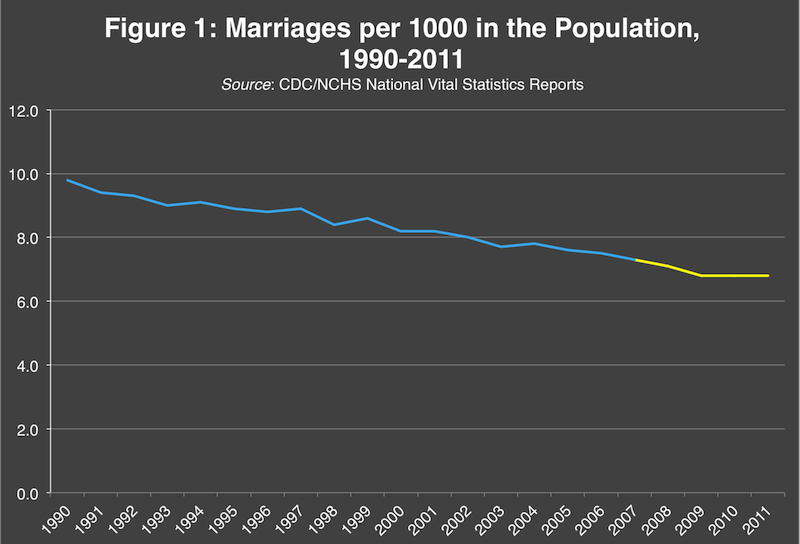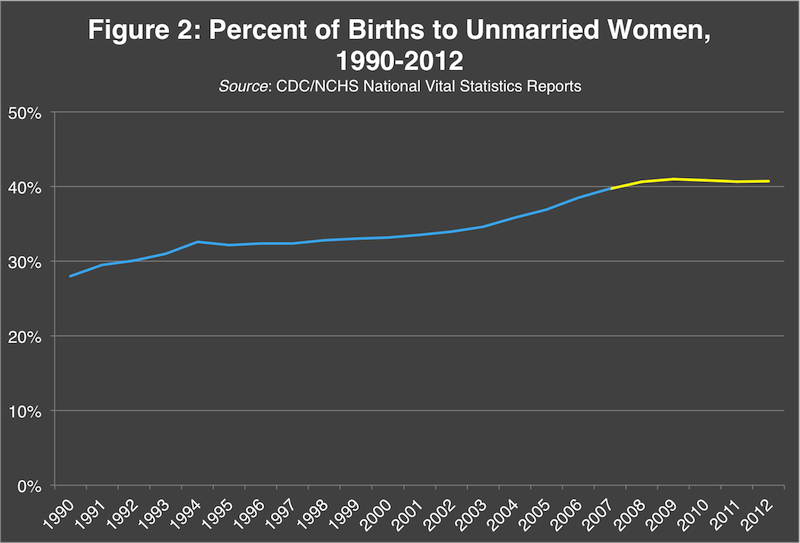Highlights
From the vantage point of the checkout line, the news doesn’t look good. From a recent Time cover story wondering if there is any “hope for the American Marriage” to this week’s In Touch cover story, “Dumped!”, chronicling the latest relationship drama enveloping Kanye, Kim, and their new baby, the news cycle seems to bring one story after another indicating that marriage is on the rocks.
But outside of the media glare, there are a number of signs—demographic and cultural—that marriage is not dead yet, and that the nation’s retreat from marriage may have bottomed out. Take the marriage rate, which has fallen more than 50 percent since the 1970s. Since 2009, the marriage rate looks to have stabilized at about 6.8 marriages per 1,000 Americans (see Figure 1). And, because the population is growing, the number of Americans actually tying the knot has been rising since 2009, from 2.08 million marriages that year to 2.12 million marriages in 2011, with more marriages forecast for this year.

Even more promising, the dramatic increases the nation has witnessed in nonmarital childbearing for the last half-century came to a halt in 2008. In the wake of the Great Recession, nonmarital childbearing has accounted for 41 percent of all births from 2008 to the present (see Figure 2). This is the first time in at least 40 years that the percentage of children being born outside of wedlock has remained stable for five years.

So, what gives? When it comes to the leveling off of nonmarital childbearing, the Great Recession is a big part of the story. Younger and less-educated women have cut back markedly on their childbearing since the recession hit. In all likelihood, young women who don’t have a good partner and a good plan are less likely to make a go at motherhood in an economic climate that makes the prospect of parenthood more daunting.
But the enduring appeal of marriage for most Americans may also be part of the story for both of the trends noted above. For the vast majority of Americans, marriage remains an integral part of the American Dream. A recent National Marriage Project study found that about 80 percent of young adults consider marriage an “important” part of their life plans. The enduring appeal of marriage may translate into a floor for the marriage rate, insofar as a substantial share of Americans remain committed to tying the knot, and a ceiling for the nonmarital childbearing rate, insofar as a substantial share of Americans remain committed to having their children in wedlock.
Only time will tell if this recent stabilization in marriage and nonmarital childbearing is the harbinger of some “new normal,” or just a temporary interruption to a European-style decline in marriage that is destined to restart in a year or two. But, for now at least, it seems that marriage in America isn’t dead yet.














